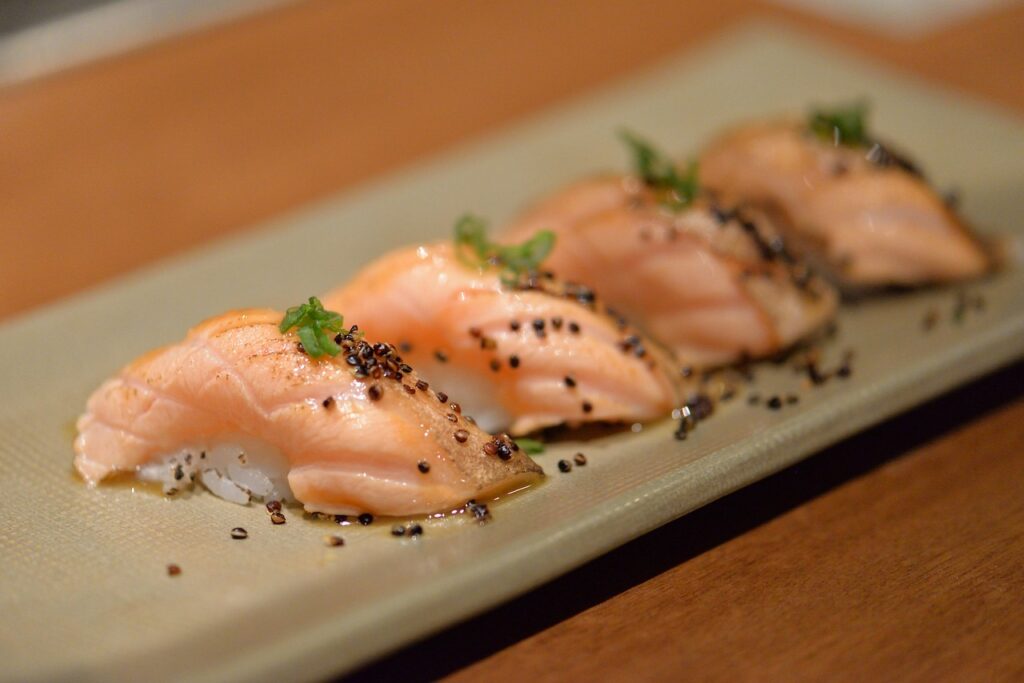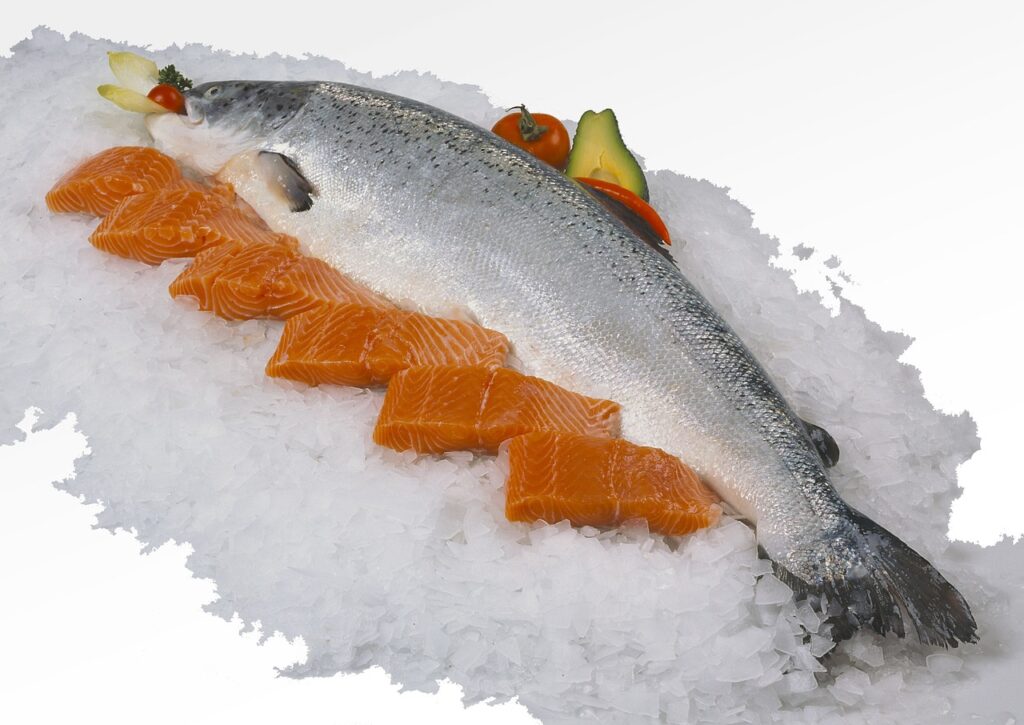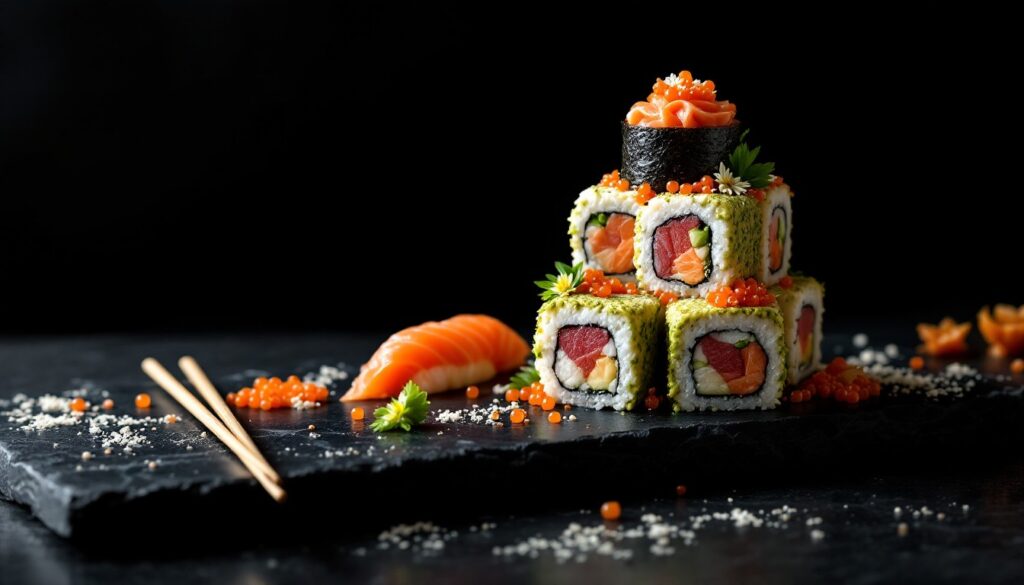Understanding Sushi-Grade Salmon
Sushi-grade salmon is a premium category of fish that meets rigorous safety and quality standards, making it safe and suitable for raw consumption. Understanding what qualifies salmon as sushi-grade, along with its health and safety considerations, as well as the differences between farmed and wild salmon, is essential for both sushi enthusiasts and professionals in the culinary field.
Table of contents
What Qualifies Salmon as Sushi-Grade?
- Stringent Quality Standards:
- Sushi-grade salmon is the highest-quality fish available, often sourced from suppliers specializing in seafood for raw consumption.
- It undergoes rigorous inspection to ensure it is free from parasites, toxins, and contaminants.
- Freezing Requirements:
- The U.S. Food and Drug Administration (FDA) mandates specific freezing protocols for fish intended for raw consumption to eliminate parasites.
- Flash Freezing: Fish must be frozen at -31°F (-35°C) or below until solid and then stored at that temperature for at least 15 hours.
- Alternatively, freezing at -4°F (-20°C) for seven days is also acceptable.
- These processes kill harmful organisms, ensuring the fish is safe to eat.
- Freshness and Handling:
- Sushi-grade salmon is handled with extreme care to maintain freshness, including rapid processing after catch, cold-chain transportation, and minimal exposure to contamination.
Health and Safety Considerations

Parasites:
Wild salmon is naturally exposed to parasites such as tapeworms and nematodes. Therefore, proper freezing is critical to neutralize these risks.
In contrast, farmed salmon, often raised in controlled environments, has a lower risk of parasite exposure.
Bacteria and Contamination:
Salmon must be processed and stored in hygienic conditions to prevent bacterial growth, such as Listeria and Salmonella. Moreover, cross-contamination during handling can compromise the safety of the fish.
Mercury and Toxins:
Mercury levels in salmon are generally low compared to other fish like tuna. Nevertheless, sourcing from reputable suppliers provides further assurance of safety.
Farmed vs. Wild Salmon for Sushi
- Farmed Salmon:
- Parasite Risk: Lower due to controlled farming environments and monitored feed.
- Fat Content: Higher fat content leads to a rich, buttery texture preferred in sushi.
- Availability: Farmed salmon is available year-round and is more cost-effective.
- Color: Artificial pigmentation is sometimes used to achieve the desired orange-pink hue.
- Wild Salmon:
- Parasite Risk: Higher risk due to exposure to natural ecosystems.
- Flavor Profile: More robust and distinct flavor, with leaner meat.
- Seasonality: Availability is limited to specific fishing seasons, which can affect cost and freshness.
- Environmental Considerations: Seen as more sustainable in some regions, though overfishing concerns persist.
Key Takeaways for Sushi Enthusiasts
- Safety First: Always purchase sushi-grade salmon from reputable suppliers that adhere to FDA freezing standards.
- Farmed vs. Wild: Decide based on your preference for texture and flavor, but consider safety measures more critically with wild salmon.
- Storage and Handling: Proper refrigeration and minimal handling are essential to maintain the safety and quality of sushi-grade salmon.
Tools Needed to Prepare Salmon for Sushi
Preparing salmon for sushi requires precision, skill, and the right tools. Having the proper kitchen equipment ensures you can handle the fish safely and achieve the delicate cuts required for sushi-making. Below are the essential kitchen tools, guidelines for choosing the right knife, and tips for maintaining your tools.
Essential Kitchen Tools
- Cutting Board:
- Opt for a large, non-slip cutting board to provide enough space for filleting and slicing.
- Use a separate board for fish to avoid cross-contamination with other foods.
- Fish Tweezers or Pliers:
- Specialized tools for removing pin bones from the salmon fillet without damaging the flesh.
- Food-Grade Gloves:
- Wearing gloves ensures hygienic handling of raw fish, reducing the risk of contamination.
- Kitchen Scale:
- Useful for portioning salmon precisely, especially for sushi rolls or nigiri.
- Plastic Wrap or Wax Paper:
- Helps prevent the fish from drying out during preparation or storage.
- Freezer or Ice Pack:
- Keeping the fish cold during handling is crucial for freshness and safety.
Choosing the Right Knife
- Yanagiba Knife (Sashimi Knife):
- A long, single-beveled knife designed for slicing fish into thin, even pieces.
- Its sharpness ensures clean cuts without tearing the delicate salmon flesh.
- Deba Knife:
- A heavy, sturdy knife ideal for filleting whole fish and cutting through bones.
- Used during the initial breakdown of a whole salmon.
- Flexible Fillet Knife:
- A versatile alternative for home cooks, suitable for removing skin and filleting fish.
- Features to Consider:
- Sharpness: A razor-sharp edge is essential for smooth, precise cuts.
- Material: High-carbon stainless steel resists rust and holds a sharp edge longer.
- Handle: Comfortable and ergonomic handles offer better control during intricate work.
Cleaning and Maintenance of Tools
- Proper Cleaning:
- Wash knives and tools immediately after use with warm, soapy water to prevent bacteria buildup.
- Avoid soaking knives for extended periods, as it can damage the blade and handle.
- Sanitization:
- Disinfect tools with food-safe sanitizers or a diluted bleach solution (1 tablespoon bleach per gallon of water).
- Use a separate sponge or brush for cleaning fish-related tools.
- Knife Maintenance:
- Regularly hone the blade with a whetstone or knife sharpener to maintain its edge.
- Store knives in a protective sheath or knife block to prevent dulling or accidents.
- Cutting Board Care:
- Scrub cutting boards thoroughly after use and sanitize them to eliminate odors and residues.
- Replace cutting boards if they develop deep grooves, as these can harbor bacteria.
Selecting the Perfect Salmon

The quality of salmon is one of the most critical factors in preparing sushi. Selecting the right fish ensures the best taste, texture, and safety for raw consumption. This guide covers how to source fresh salmon, recognize quality indicators, and consider ethical and sustainable practices when choosing your fish.
How to Source Fresh Salmon
- Purchase from Reputable Suppliers:
- Buy salmon from trusted fish markets, seafood counters, or specialized suppliers known for high-quality sushi-grade fish.
- Look for establishments that follow stringent handling and freezing practices to eliminate parasites.
- Ask for Sushi-Grade:
- Specifically request sushi-grade salmon, as it has been processed and frozen according to FDA guidelines to make it safe for raw consumption.
- Consider the Origin:
- Salmon sourced from regions with robust fishing or farming regulations, such as Norway, Alaska, or Scotland, often guarantees superior quality.
- Timing and Freshness:
- Shop for salmon early in the day when fish counters are freshly stocked.
- Avoid pre-packaged options unless they are clearly labeled and come from a reputable source.
Recognizing Quality Indicators
- Appearance:
- Look for bright, vibrant flesh with a consistent orange-pink hue (depending on the species).
- Avoid salmon with dull, faded, or discolored spots.
- Texture:
- Fresh salmon should have firm flesh that bounces back when pressed lightly.
- Avoid fish that feels mushy or has a slimy surface.
- Smell:
- Fresh salmon should have a clean, mild aroma reminiscent of the ocean.
- A strong, fishy, or sour smell is a sign of spoilage.
- Skin and Scales:
- If buying whole salmon, ensure the skin is shiny, smooth, and free of blemishes.
- Scales should be intact and not falling off easily.
- Moisture Content:
- Salmon fillets should have a slightly moist but not overly wet surface. Excess liquid pooling in the packaging is a red flag.
Ethical Considerations
- Sustainability:
- Choose salmon from sustainable fisheries or eco-certified farms (e.g., MSC or ASC certifications) to minimize environmental impact.
- Wild salmon may have a lower carbon footprint, but some species are overfished, requiring careful selection.
- Farmed vs. Wild:
- Farmed Salmon: Often raised with lower parasite risks and controlled diets but may face criticism for environmental concerns such as water pollution and habitat disruption.
- Wild Salmon: While considered more natural and environmentally friendly, overfishing can pose significant challenges to certain populations.
- Traceability:
- Opt for suppliers that provide transparency about the fish’s origin, harvesting methods, and handling processes.
- Social Responsibility:
- Support fisheries or farms that prioritize fair labor practices and humane treatment of workers.
Preparing Your Workspace
A well-prepared workspace is essential for creating sushi with precision and maintaining hygiene. Proper cleanliness, organization, and efficiency ensure a safe and enjoyable sushi-making experience.
Ensuring Cleanliness
- Sanitize Surfaces:
- Clean countertops and work surfaces with food-safe sanitizer or a mix of water and vinegar.
- Dry surfaces thoroughly before starting to avoid slipping or contamination.
- Wash Hands:
- Wash hands thoroughly with soap and warm water before and during food preparation, especially after handling raw fish.
- Use Clean Utensils:
- Ensure knives, cutting boards, and other tools are cleaned and disinfected before use.
- Use separate tools for fish and other ingredients to prevent cross-contamination.
- Wear Protective Gear:
- Use disposable food-grade gloves and change them frequently during preparation.
- Consider wearing an apron to keep your clothing clean and free from contaminants.
Organizing Your Tools
- Keep Tools Within Reach:
- Arrange knives, fish tweezers, and other essential tools within arm’s reach for convenience.
- Use a magnetic knife strip or a dedicated stand to keep knives safely accessible.
- Separate Zones:
- Dedicate separate areas for raw fish preparation, ingredient assembly, and plating to maintain hygiene and workflow.
- Use Containers:
- Organize ingredients such as rice, seaweed, and vegetables in small bowls or containers for quick access.
- Prepare Waste Disposal:
- Set up a trash bin or bowl nearby to discard trimmings and scraps efficiently.
Setting Up for Efficiency
- Plan Your Workflow:
- Arrange tools and ingredients in the order they’ll be used to streamline the process.
- Prepare all ingredients, such as cooked rice or sliced vegetables, before handling raw fish.
- Temperature Control:
- Keep raw salmon on a bed of ice or a chilled surface to maintain freshness while working.
- Lighting and Space:
- Ensure your workspace is well-lit and uncluttered to focus on precision tasks, such as cutting and plating.
Properly Handling Raw Salmon

Handling raw salmon with care is crucial for ensuring its safety and quality. Follow these guidelines for safe thawing, preventing cross-contamination, and optimal storage.
Safe Thawing Techniques
- Refrigerator Thawing:
- Thaw salmon gradually in the refrigerator for 12–24 hours. Place it on a plate or in a sealed container to catch any liquid.
- Cold Water Method:
- Submerge the salmon (in its packaging or a sealed bag) in a bowl of cold water, changing the water every 30 minutes. This method is faster but must be done carefully to avoid temperature abuse.
- Avoid Countertop Thawing:
- Never thaw salmon at room temperature, as this encourages bacterial growth.
Avoiding Cross-Contamination
- Dedicated Tools:
- Use separate knives, cutting boards, and utensils for raw fish and other ingredients.
- Label or color-code tools to differentiate them.
- Immediate Cleaning:
- Wash tools and surfaces immediately after handling raw salmon with hot, soapy water and sanitize them thoroughly.
- Separate Storage:
- Store raw salmon away from cooked or ready-to-eat foods, preferably on the lowest shelf of the refrigerator to avoid dripping onto other items.
Optimal Storage Tips
- Temperature Control:
- Keep raw salmon at or below 40°F (4°C) to prevent spoilage.
- Use a refrigerator thermometer to monitor storage conditions.
- Airtight Packaging:
- Store salmon in vacuum-sealed or tightly wrapped plastic to prevent exposure to air and odors.
- Time Limits:
- Consume fresh raw salmon within 1–2 days of purchase.
- If freezing, use it within 2–3 months for best quality and ensure it was properly frozen according to sushi-grade standards.
- Freezing for Longevity:
- If you don’t plan to use the salmon immediately, freeze it at -4°F (-20°C) or below in vacuum-sealed packaging.
Most Popular Sushi Recipe: California Roll

The California Roll is one of the most iconic sushi recipes, loved for its mild flavors and simplicity. Here’s how to make it:
Ingredients
- Sushi Rice
- 2 cups short-grain rice
- 2 1/2 cups water
- 1/3 cup rice vinegar
- 3 tbsp sugar
- 1 tsp salt
- Filling
- 1 avocado, thinly sliced
- 1 cucumber, julienned
- 1 cup imitation crab meat (or real crab if preferred)
- Other Essentials
- 4 sheets of nori (seaweed)
- Soy sauce, pickled ginger, and wasabi for serving
Instructions
1. Prepare the Sushi Rice
- Rinse the rice until the water runs clear.
- Cook the rice with water in a rice cooker or on the stove.
- Once cooked, transfer to a large bowl.
- Mix rice vinegar, sugar, and salt, then gently fold into the rice. Let it cool.
2. Set Up Your Rolling Station
- Place a bamboo mat on a flat surface and cover it with plastic wrap to prevent sticking.
3. Assemble the Roll
- Lay a sheet of nori, shiny side down, on the bamboo mat.
- Spread a thin layer of rice over the nori, leaving a 1-inch border at the top.
- Place avocado slices, cucumber, and crab meat in a line across the middle of the rice.
4. Roll the Sushi
- Use the bamboo mat to lift the edge of the nori closest to you.
- Roll tightly, pressing gently to shape the roll. Seal the edge with a bit of water.
5. Slice and Serve
- Use a sharp knife dipped in water to slice the roll into 6-8 pieces. Serve with soy sauce, pickled ginger, and wasabi.
FAQs About Preparing Salmon for Sushi
1. What is sushi-grade salmon?
Sushi-grade salmon is processed and frozen to meet safety standards for raw consumption, ensuring it’s free from parasites and high in quality.
2. Can I use any salmon for sushi?
No. Only use salmon labeled as “sushi-grade” or “sashimi-grade,” sourced from trusted suppliers.
3. How do I thaw sushi-grade salmon?
Thaw in the fridge for 12–24 hours or in cold water, changing the water every 30 minutes. Never thaw at room temperature.
4. How can I tell if salmon is fresh?
Fresh salmon is firm, bright in color, and has a mild, clean smell. Avoid slimy or discolored fish.
5. What tools do I need?
A sharp knife, fish tweezers, a clean cutting board, and food-grade gloves are essential.
6. How do I store sushi-grade salmon?
Refrigerate at 40°F (4°C) for up to 2 days or freeze at -4°F (-20°C) for up to 3 months. Do not refreeze thawed salmon.
Conclusion
Preparing salmon for sushi at home can be an enjoyable and rewarding experience when done with care and attention to detail. Here are the key takeaways:
- Safety First: Always use sushi-grade salmon sourced from reputable suppliers, and handle it with proper hygiene to ensure safety.
- Proper Tools: Invest in the right tools, such as a sharp knife and fish tweezers, to achieve precision and maintain quality.
- Handling and Storage: Follow safe thawing techniques, avoid cross-contamination, and store salmon correctly to preserve its freshness.
With these guidelines, you’re ready to experiment confidently and create delicious sushi. Embrace the process, enjoy the art of preparation, and share your creations with pride.

